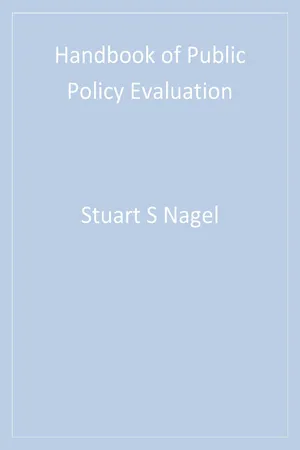
This is a test
- 424 pages
- English
- PDF
- Available on iOS & Android
eBook - PDF
Handbook of Public Policy Evaluation
Book details
Table of contents
Citations
About This Book
Handbook of Public Policy Evaluation is the only book of its kind to present aspects of public policy evaluation that relate to economic, technology, social, political, international, and legal problems. Rather than looking at specific narrowly focused programs, this book emphasizes broad-based evaluation theory, study, and application, providing a rich variety of exceptional insights and ideas.
Frequently asked questions
At the moment all of our mobile-responsive ePub books are available to download via the app. Most of our PDFs are also available to download and we're working on making the final remaining ones downloadable now. Learn more here.
Both plans give you full access to the library and all of Perlego’s features. The only differences are the price and subscription period: With the annual plan you’ll save around 30% compared to 12 months on the monthly plan.
We are an online textbook subscription service, where you can get access to an entire online library for less than the price of a single book per month. With over 1 million books across 1000+ topics, we’ve got you covered! Learn more here.
Look out for the read-aloud symbol on your next book to see if you can listen to it. The read-aloud tool reads text aloud for you, highlighting the text as it is being read. You can pause it, speed it up and slow it down. Learn more here.
Yes, you can access Handbook of Public Policy Evaluation by Stuart S. Nagel in PDF and/or ePUB format, as well as other popular books in Política y relaciones internacionales & Política pública. We have over one million books available in our catalogue for you to explore.
Information
Table of contents
- Cover
- Contents
- Introduction
- Section I: FOUNDATION IDEAS
- Part 1: WIN-WIN METHODS
- 1 - Win-Win Analysis Summarized
- 2 - The Big Tradeoff: Fundamental Law or Red Herring?
- 3 - Win-Win Equity
- 4 - Lose-Lose and Win-Win Policies
- 5 - Graphic Approaches to Understanding Super-Optimizing
- Part 2: WIN-WIN EXAMPLES
- 6 - Preventing Sexual Harassment While Preserving Academic Freedom: A Win-Win Analysis
- 7 - Two Super-Optimum Solutions in a Cutback Mode
- 8 - University to Industry Transfer
- 9 - Profit Sharing and Job Anxiety: Moving Public Policy Toward a Win-Win Solution
- 10 - Another Win-Win Occurrence
- Part 3: PUBLIC POLICY STUDIES
- 11 - Policy Evaluation Questions
- 12 - Integrating Institutions and Implementation Into Policy Decisions
- 13 - Public and Private Sectors for Administering Public Functions
- 14 - Sherman the Shark on Policy Evaluation
- Part 4: POLICY PROFESSIONALISM
- 15 - Productivity for Success
- 16 - Professionalism Books for Graduate Students and Others
- 17 - Survey on Running a Policy Program
- 18 - Academic Tyranny: The Tale and the Lessons
- Part 5: POLICYMAKER PERSPECTIVES
- 19 - Public Health Challenges
- Section II: POLICY EVALUATION AT THE CUTTING EDGE
- Part 1: BASIC CONCEPTS
- 20 - Policy Theory
- 21 - Building Frameworks for Policy Analysis
- 22 - Causal Relations Among Policy Fields
- Part 2: METHODS AND PROFESSIONALISM
- 23 - Diverse Methods for Policy Analysis
- 24 - Interactive Policy Analysis: Process Methods for Policy Reform
- 25 - Changing Policy Research
- 26 - Recruiting People and Obtaining Funds
- 27 - Funding for Policy Evaluation
- Part 3: POLICY EVALUATION TRENDS
- 28 - Trends in Cross-Cutting Procedural Policy Issues
- 29 - Public Policy in the 20th Century
- 30 - The Future of the Policy Studies Organization
- Part 4: POLICY EVALUATION SUBSTANCE
- 31 - Welfare Reform
- 32 - “Ordinary” Injustice: A Memo to the Editor
- 33 - Congressional Campaign Reform
- 34 - Violence, Guns, Media, and Fathers
- Part 5: WIN-WIN THEORY
- 35 - Super-Optimizing Solution Graphing
- 36 - Win-Win Game Theory
- 37 - Win-Win Mediation
- 38 - Win-Win Allocation
- 39 - Inconsistent Reactions to Win-Win Analysis
- Part 6: WIN-WIN APPLICATIONS
- 40 - Coeffects Diagrams and Win-Win Analysis
- 41 - Win-Win Economics
- 42 - Super-Optimization: A New Approach to National Environmental Policymaking
- 43 - Win-Win Decentralizing
- 44 - Win-Win Justice
- Section III: POLICY EVALUATION BIBLIOGRAPHIES
- Part 1: POLICY EVALUATION IN GENERAL
- 45 - Core Bibliography and Background
- 46 - Policy Problems or Subfields
- Part 2: POLICY STUDIES ORGANIZATION BOOKS
- 47 - Policy Studies Organization Policy Books
- 48 - Recent Policy Studies Organization Policy Books
- 49 - The Impact of Policy Studies Organization Books
- Part 3: ALTERNATIVE DISPUTE RESOLUTION (ADR) AND SUPER-OPTIMUM SOLUTION (SOS)
- 50 - Alternative Dispute Resolution
- 51 - Literature Relevant to Super-Optimum Solutions
- 52 - Super-Optimum Solution Publications
- 53 - Bibliography From Creativity in Public Policy: Generating Super-Optimum Solutions
- 54 - Further Reading on Super-Optimum Solutions
- Part 4: PROFESSIONALISM IN POLICY EVALUATION
- 55 - Obtaining Funding
- 56 - Getting Published
- 57 - Finding an Academic Niche
- 58 - Creativity
- Part 5: PUBLIC POLICY AND OTHER DISCIPLINES
- 59 - Natural Science
- 60 - Humanities
- 61 - Social Science
- Part 6: SPECIAL RESOURCES
- 62 - Policy Problems by Developing Regions
- 63 - Policy Studies Organization Books
- 64 - Legal Policy
- Index
- About the Editor